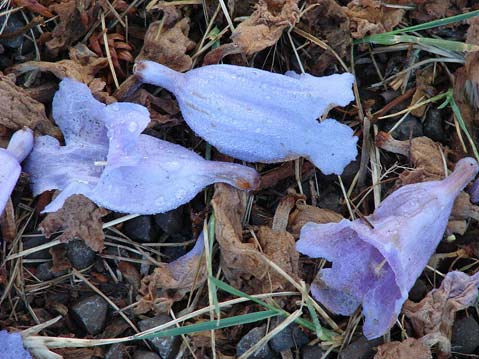Twigs
Bare Twigs Make for Lovely Arrangements

Soon the leaves will be falling from the peach and plum trees in the orchard and Japanese maples, poplars, and liquidambars in the landscape. Some of these deciduous species will spend several months in their winter nakedness, while others like ornamental pear (Pyrus kawakamii), which can be totally evergreen in the mildest places, usually has a brief bare period during the coldest months. In Santa Barbara, the golden rain tree (Koelreuteria paniculata) and the jacaranda (Jacaranda mimosifolia) will also litter the streets for just a few weeks or so and then leaf out with vibrant new greenery.
Leaves are actually the engine of a plant. They convert light energy from the sun into chemical energy for their growth. The by-product of this process is, of course, oxygen, but it needs to escape into the atmosphere and the carbon dioxide that is the main raw ingredient in photosynthesis needs to be brought into the plant. All this happens through tiny pores on the surface of the leaf. Another volatile molecule in this process is water, and it, too, has to exit the plant through these small mouths (stomata). So, during this naked phase, as the tree (or shrub) stands leafless, it is not transporting gases, or energy; it is dormant. This is a great time to take a good look at the structure of the plant and do any pruning necessary to shape it ornamentally, force growth and fruit production, or just reduce the size of the woody plant. Consult a good pruning guide for the particulars of any given species (they can vary widely).
Those prunings may go on to fulfill another destiny. For one thing, these bare twigs can be quite architectural in their own right. Select some with interesting curves or arrow-sharp straightness and incorporate them into a fall arrangement, either with other fall gleanings such as dried flower stalks from the garden or as a skeletal base for fresh flowers.
Sturdier stalks and branches can be stored to use next year as natural-looking supports for floppy perennials, tomatoes, and more. Those nice straight fruit tree shoots and even some of the branched sticks can be recycled for at least one season and lend a more natural look to the garden. Shove a woody plum twig into the soil near the main stem when the tender plant is still young and make sure it will be tall enough to accommodate the plant’s ultimate height. Tie the stem to the stake tightly enough to be secure, but loosely enough to allow some room for future growth. Even the flower spikes of potted orchids, from cymbidiums to phalaenopsis, can be attractively supported with easily harvested garden clippings.
These are good uses for the unprepossessing twigs of common species, such as white mulberry (Morus alba, the species fed to silkworms in Asia). It has strong branching patterns, but also needs serious annual pruning, and thus is a prime candidate for a renewable source of slender whips for any use. There are also other choices that lend a colorful presence in the garden even if they are not gleaned for decorative uses. Redtwig dogwood (Cornus stolonifera) will reliably lose its leaves to reveal blood-red stems to provide winter interest all over the state (even in mild winter zones). Hawthorns (Crataegus species), curly willow (Salix matsudana), and Harry Lauder’s walking stick (Corylus avellana ‘Contorta’) are other good choices for wintertime interest.



